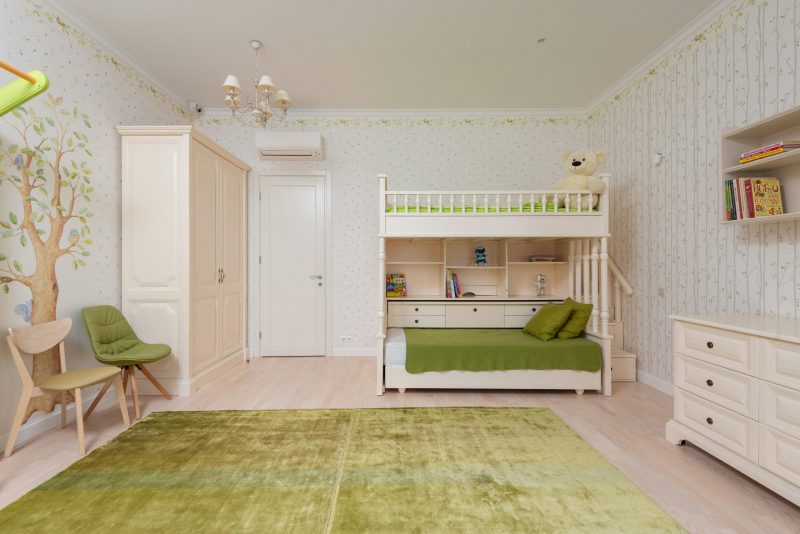Choosing a bed for a growing child isn’t just a style decision. It’s storage, safety, daily routine, and future-proofing—rolled into one piece of furniture. Bedrooms are doing more than ever: homework, gaming, sleepovers, quiet reading time. The right bed helps all of that feel smoother.
Below, you’ll find five brands that consistently deliver for families. Each section opens with what they do well.

Via Pexels
1) Millie & Jones
Best for… planet-positive kids’ beds that are genuinely designed for childhood and the teen years
Family-run and laser-focused on one thing—beds for children and teenagers—Millie & Jones builds its range around how real homes work. You’ll see high sleepers with smart desks, day beds that double as lounge spots, and tidy under-bed storage that swallows clutter without swallowing the room. The collection feels curated for small footprints, shared rooms, and the constant shift from “little kid” to “needing their own space.”
There’s substance beneath the styling. The brand plants five trees for every order, a clear promise you can explain to your child when the boxes arrive. Service is personal and responsive—the tone is helpful, not scripted—which makes tricky choices far easier. If you’re moving a toddler to a first bed or stepping up to teen-ready furniture, the guidance feels considered.
Pros
- Genuine “grow with them” architecture; re-use components instead of rebuying.
- Calm Scandinavian finish that plays nicely with any colour palette.
- Accessories and textiles let you personalise without committing to a themed bed.
Cons
- Pricing reflects long-term flexibility.
- In-person viewing can be limited, so measuring carefully at home matters.
2) Hoppekids
Best for… modular builds that evolve from early years to mid-teens
Danish design meets family pragmatism. Hoppekids is known for modular frames that you reconfigure as needs change—low single today, mid-sleeper next term, then a loft bed with a quiet desk when secondary school starts. Surfaces are calm and matte; rooms feel lighter, which helps small spaces breathe.
The brand encourages you to edit over time rather than start again. Swap legs, add safety rails, add a ladder, remove it later. The ecosystem is coherent, so upgrades don’t look bolted on. If you like one clean look that matures well, this route is satisfying.
Pros
- Genuine “grow with them” architecture; re-use components instead of rebuying.
- Calm Scandinavian finish that plays nicely with any colour palette.
- Accessories and textiles let you personalise without committing to a themed bed.
Cons
- Pricing reflects the long-term flexibility.
- In-person viewing can be limited, so measuring carefully at home matters.
3) Furniture Village – Kids & Teens
Best for… seeing beds in person and sorting finance without drama
If you like to check ladder angles, rail heights, and drawer glides before you buy, Furniture Village is practical. The kids and teens range spans bunks, mid-sleepers, high sleepers with desks, and tidy divans with drawers. Showrooms mean you can test sturdiness and lie down on a mattress rather than guessing from a product page.
There’s a broad spread of price points and frequent promotions. That helps if you’re kitting out a room all at once—bed, mattress, storage—without juggling multiple retailers. The look is mainstream rather than niche, but that’s a positive if you want plug-and-play choices and straightforward delivery.
Pros
- Try-before-you-buy across stores nationwide; helpful for safety-first decisions.
- Broad selection and regular deals make budgeting easier.
- Coordinating pieces in the same finish for a quick, cohesive setup.
Cons
- A generalist approach means fewer made-for-kids flourishes than specialist brands.
- Niche colourways or ultra-compact footprints may be hit-and-miss.
4) Argos – Kids’ Beds
Best for… speed, availability, and “we need it this weekend” moments
When timing is tight, Argos is easy to work with. Stock levels are clear, and delivery or click-and-collect can be fast. The catalogue runs from simple single beds to bunks, themed frames, and cabin beds with drawers—so you can match budget and urgency without compromise on the basics.
Read the specs. Argos lists dimensions and maximum mattress depths, which helps you avoid ladders that cut across windows or drawers that clash with doors. If you’re furnishing a rental or guest room for cousins and sleepovers, the value is strong.
Pros
- Wide availability and quick fulfilment.
- Big range of sizes and formats for different room layouts.
- Straightforward returns if it doesn’t suit the space.
Cons
- Quality varies between collections; scrutinise materials and weight limits.
- Fewer integrated study features than dedicated high-sleeper specialists.
5) Room to Grow
Best for… curated kids’ beds with guidance that feels like a conversation
Room to Grow focuses on children’s bedrooms with a mix of bunks, cabin beds, mid/high sleepers, and neat storage beds. The selection feels edited: pieces earn their place because they solve specific problems—low ceilings, shared rooms, awkward alcoves. Product pages are unusually useful, with real measurements and practical notes that help you plan before the boxes arrive.
Service is a differentiator here. If you’re unsure whether a mid-sleeper will overwhelm a narrow room, their advice is measured and specific. The result is a room that looks intentional rather than crowded, and a bed your child will use for years rather than months.
Pros
- Curated range with clear guidance on who a bed suits and why.
- Strong on space-saving formats for small or shared rooms.
- Accessories, mattresses, and storage that actually match the frames.
Cons
- Pricing sits mid to upper, reflecting the curation.
- Some models have longer lead times, so plan ahead for birthdays or moves.
Verdict
If I had to put one brand at the top for 2025, it’s Millie & Jones. The focus on children and teens is obvious in the details: sensible ladder angles, storage that earns its keep, and designs that don’t box you in when tastes evolve. The five-trees-per-order promise is concrete and easy to feel good about. Add approachable service, and you get a path from “where do we start?” to “room sorted” without noise.
That said, every brand here has a clear role. Use the “best for” lines as your shortcut. Then measure, plan, and choose with the room in front of you—not the one in your head. You will thank yourself when bedtime runs smoothly, homework has a home, and weekends feel a little lighter.
